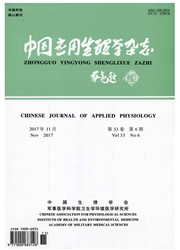

 中文摘要:
中文摘要:
High-altitude hypoxia can induce physiological dysfunction and mountain sickness,but the underlying mechanism is not fully understood.Corticotrophin-releasing factor(CRF) and CRF type-1 receptors(CRFR1) are members of the CRF family and the essential controllers of the physiological activity of the hypothalamo-pituitary-adrenal(HPA) axis and modulators of endocrine and behavioral activity in response to various stressors.We have previously found that high-altitude hypoxia induces disorders of the brain-endocrine-immune network through activation of CRF and CRFR1 in the brain and periphery that include activation of the HPA axis in a time-and dose-dependent manner,impaired or improved learning and memory,and anxiety-like behavioral change.Meanwhile,hypoxia induces dysfunctions of the hypothalamo-pituitary-endocrine and immune systems,including suppression of growth and development,as well as inhibition of reproductive,metabolic and immune functions.In contrast,the small mammals that live on the Qinghai-Tibet Plateau alpine meadow display low responsiveness to extreme high-altitudehypoxia challenge,suggesting well-acclimatized genes and a physiological strategy that developed during evolution through interactions between the genes and environment.All the findings provide evidence for understanding the neuroendocrine mechanisms of hypoxia-induced physiological dysfunction.This review extends these findings.
 英文摘要:
英文摘要:
High- altitude hypoxia can induce physiological dysfunction and mountain sickness, but the underlying mechanism is not fully understood. Corticotrophin-releasing factor (CRF) and CRF type-1 receptors (CRFR1) are members of the CRF family and the essential controllers of the physiological activity of the hypothalamo-pituitary-adrenal (HPA) axis and modulators of endocrine and behavioral activity in response to various stressors. We have previously found that high-altitude hypoxia induces disorders of the brain-endocrine-immune network through activation of CRF and CRFR1 in the brain and periphery that include activation of the HPA axis in a time- and dose-dependent manner, impaired or improved learning and memory, and anxiety-like behavioral change. Meanwhile, hypoxia induces dysfunctions of the hypothalamo-pituitary-endocrine and immune systems, including suppression of growth and development, as well as inhibition of reproductive, metabolic and immune functions. In contrast, the small mammals that live on the Qinghai-Tibet Plateau alpine meadow display low responsiveness to extreme high-altitude- hypoxia challenge, suggesting well-acclimatized genes and a physiological strategy that developed during evolution through interactions between the genes and environment. All the findings provide evidence for understanding the neuroendocrine mechanisms of hypoxia-induced physiological dysfunction. This review extends these findings.
 同期刊论文项目
同期刊论文项目
 同项目期刊论文
同项目期刊论文
 CRHR1 mediates p53 transcription induced by high altitude hypoxia through ERK 1/2 signaling in rat h
CRHR1 mediates p53 transcription induced by high altitude hypoxia through ERK 1/2 signaling in rat h 期刊信息
期刊信息
